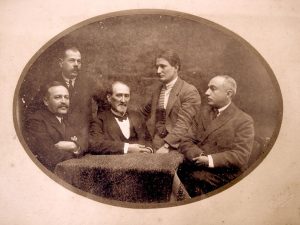Ben Avigdor (Shalkovich, Avraham Leib)
 Shalkovich, Avraham Leib (1866–1921), Hebrew writer and publisher, known alternately by his pseudonym, Ben-Avigdor. Born in Zaludok, near Vilna, Shalkovich grew up in Zhetl, a village in the province of Grodno. Though he attended Lithuanian yeshivas, he became a maskil and subsequently traveled to Kovno, where he studied for his university entrance exams (though there is no evidence that he ever attended university). He was married to Tsiporah Blumgarten, sister of the Yiddish poet known as “Yehoyesh” (Solomon Bloomgarden).
Shalkovich, Avraham Leib (1866–1921), Hebrew writer and publisher, known alternately by his pseudonym, Ben-Avigdor. Born in Zaludok, near Vilna, Shalkovich grew up in Zhetl, a village in the province of Grodno. Though he attended Lithuanian yeshivas, he became a maskil and subsequently traveled to Kovno, where he studied for his university entrance exams (though there is no evidence that he ever attended university). He was married to Tsiporah Blumgarten, sister of the Yiddish poet known as “Yehoyesh” (Solomon Bloomgarden).
In 1889, Shalkovich moved to Vilna. That same year he published a group of well-received essays on Zionism as well as his first short story, in Ha-Melits. By 1891, he had joined the Bene Mosheh movement and was appointed secretary of its Warsaw office; it was at about this point that he adopted his nom-de-plume. (In Talmudic usage, the name Avigdor refers to Moses; hence the connection between the group Bene Mosheh and his adopted name Ben-Avigdor.) Simultaneously, he began systematically to produce inexpensive volumes of Hebrew literature in the Sifre Agorah (One-Penny Books) series. His success heralded a radical rethinking about the titles and distribution of Hebrew texts.
Under Ben-Avigdor’s leadership, a group of young maskilim (including Re’uven Brainin, Ezra Goldin, Yisra’el Ḥayim Taviov [Tawiów], David Silberbusch, Aleksander Ziskind Rabinovitz, and others known as Ha-Mahalakh he-Ḥadash [The New Movement]) rebelled against the themes and writing styles of the older followers of the Haskalah. From the end of 1891 through 1893, Ben-Avigdor’s group issued a 32-page pamphlet each fortnight, printed in a tiny font and exploring a variety of topics relevant to the Jewish community.
Ben-Avigdor seemed unable to decide whether to carry on his life as a writer or as a cultural leader. Though he met with some success in writing, he proved to be much more capable as a manager. His experience and overwhelming success with the Sifre Agorah project inspired him to set up (with the help of his colleagues Eli‘ezer Kaplan, Matityahu Kohen, and Ze’ev Gluskin) the first publicly funded Jewish printing press, which they called Aḥi’asaf. Their first undertaking was the literary annual Luaḥ Aḥi’asaf (Aḥi’asaf Calendar [Almanac]), which Ben-Avigdor edited between 1893 and 1895. By calling the publication “popular,” “literate,” and “practical,” Ben-Avigdor intended his audience to be the average reader; the subject matter, as well, was limited to familiar topics.
In 1895, Ben-Avigdor sold his share in Aḥi’asaf and founded Tushiyah, the first privately owned, modern Jewish secular printing press. With the experience he had gained in the market for Hebrew literature, he felt ready to bring innovations to Hebrew-language publishing, and envisaged texts that would energize the development of modern Hebrew culture. From this perspective, Ben-Avigdor’s thinking was in step with reality, and, in a way, was also responsible for creating it. His publishing program, which did not change for many years, was the prototype for many later Hebrew presses.
Like all multifaceted companies that had to juggle the interests of artists, writers, and printers, Tushiyah did not always enjoy an easy relationship with its staff and associates. Some of the writers were unhappy with the published versions of their books, and complained of sloppy editing. Others were disappointed with the limited numbers of copies that actually sold and with the unsatisfactory remuneration they received.
Ben-Avigdor also made substantial contributions to Yiddish publishing. The weeklies Yidishe folks-tsaytung (People’s Paper), Yidishe froyenvelt (Women’s World), and later, Di tsayt (The Times) appeared under his imprint. He also published the first edition of Sholem Aleichem’s collected works in four volumes. The collection Hilf (Help), edited by Sholem Aleichem to benefit the victims of the Kishinev pogrom, was published by Folksbildung, the Yiddish arm of Tushiyah. In 1921, when Ben-Avigdor was at the peak of his career (having expanded his company’s activities to the United States and Palestine) he died suddenly, at the age of 55.

